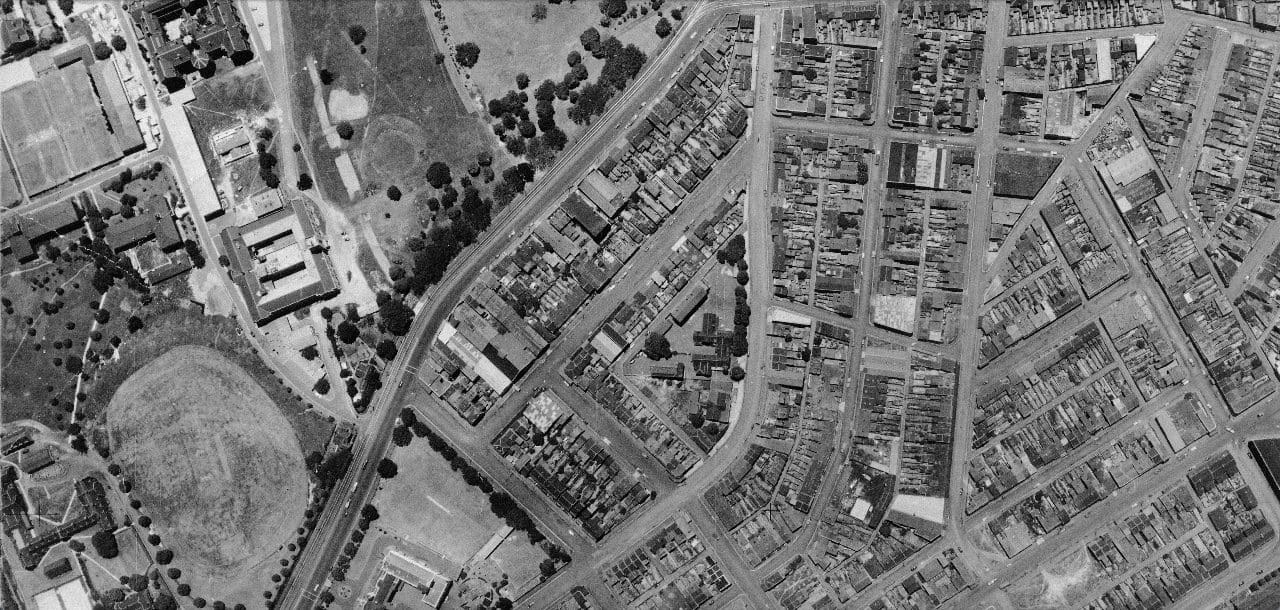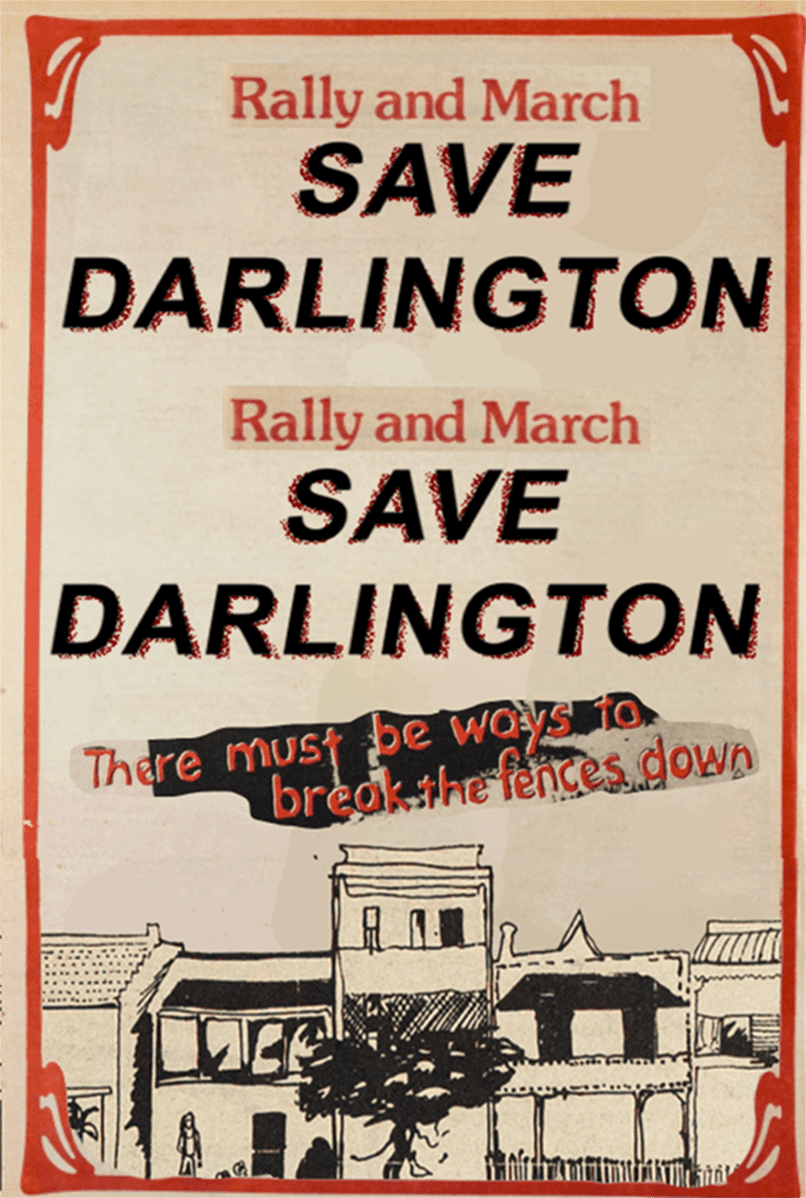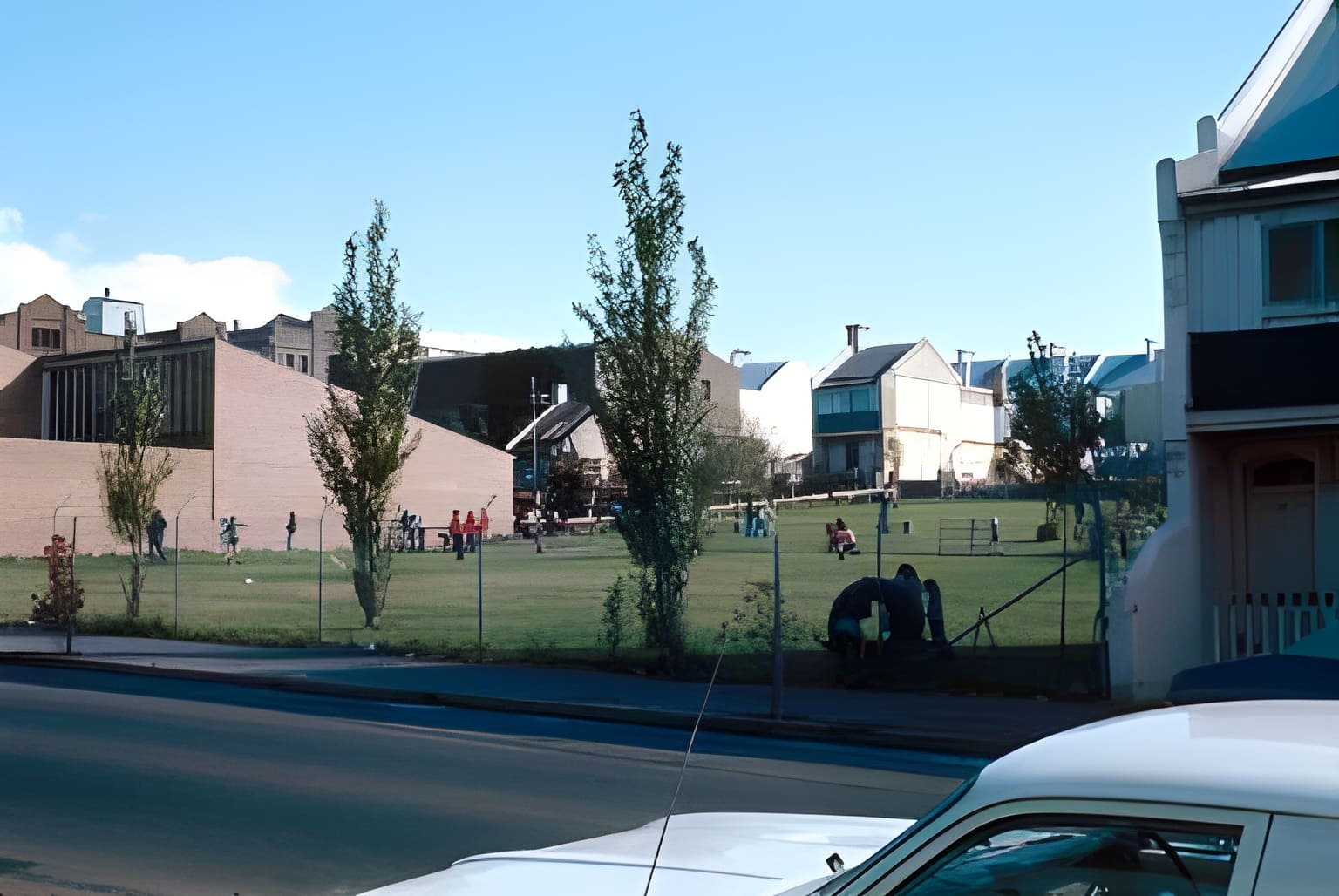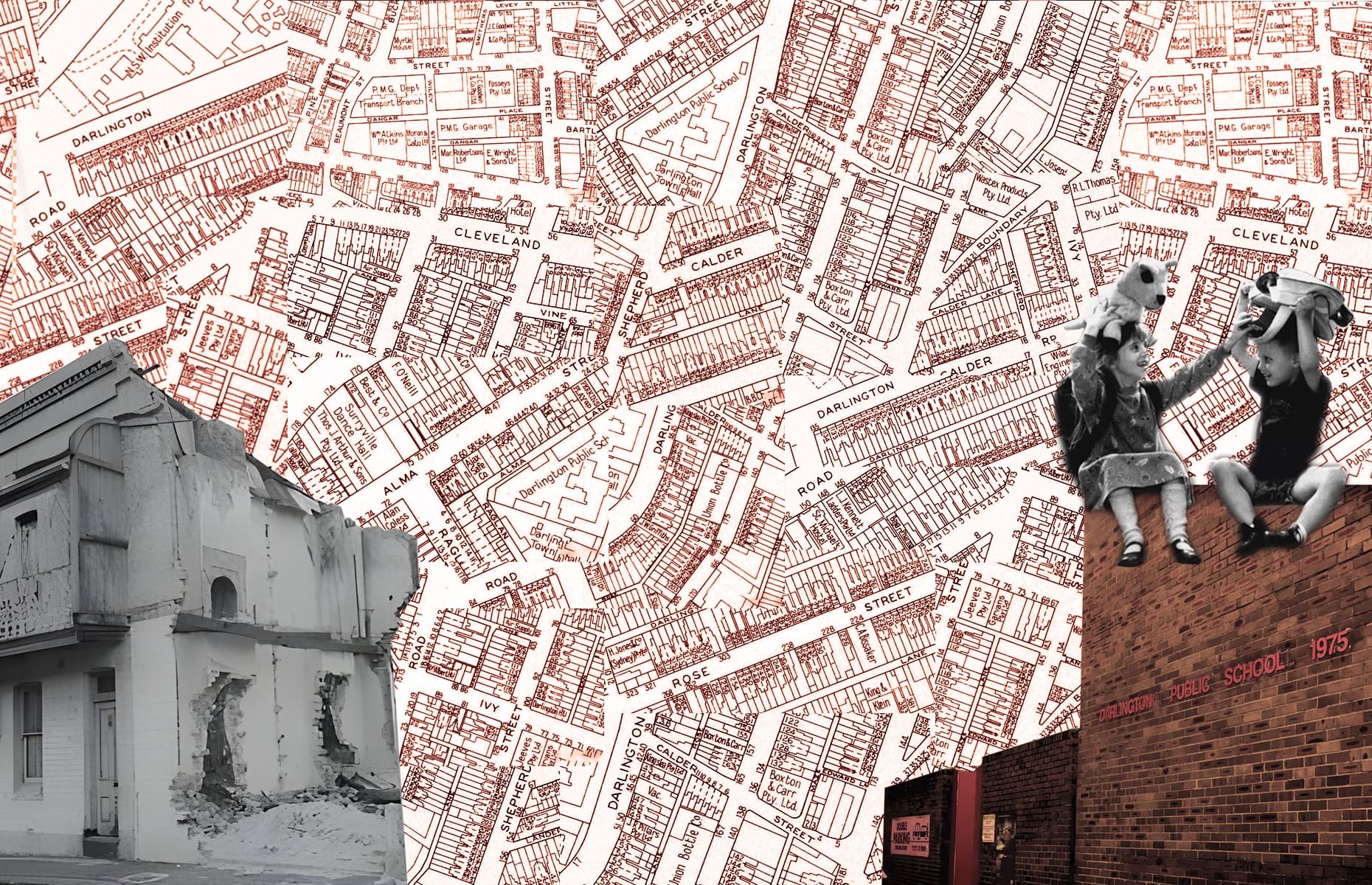Over the course of a three year degree, it’s likely you’ll spend a lot of time walking up and down Abercrombie Street. Going to and from uni, the Royal, and Carriageworks aren’t uncommon day to day experiences, and usually take students past Darlington Public School, where I was once a student. When I started at USyd, my renewed location-based connection to the school and Abercrombie Street reinforced the importance of my time there; a time which, I have come to realise, completely laid the groundwork for my understanding of preserving local communities.
The education I gained at Darlington was deeply based on principles of commonality. There was an equal emphasis on learning from those around you and their experiences as there was on the curriculum. In the process of archival digging I did to find out more about the history of this unique education, I learned that it wasn’t just my generation who had been lucky enough to experience it. In a publication about the school from 1978, there’s a quote which reads: “the children learnt as much from each other as well as from the structured lessons”. In the 2000s, our days were spent singing songs of anti-racism, not colonial rejoice. We called teaching staff Aunty and Uncle, not Miss or Sir, and we got dropped to and from school in a bus – often dropping a few teachers off on the way. When too many kids were getting in trouble in the afternoons, the school changed the finishing time to 2.30, rather than 3. And if students didn’t want to go home until then, the playground would stay open. We learnt to appreciate each other’s differences, not ignore them, and the teaching staff did the same.
It’s difficult to put into words the spirit of community that the school built – in the interviews I conducted for this article, most people expressed the same. Words like ‘luck’, ‘excitement’ and ‘joy’ came up frequently, but none of them seem to do it justice. Whether this is a result of the characteristics of the Darlington community, or if the Darlington community became what it is as a result of the cultural tone set by the school, is not entirely clear – but what I do know is that one cannot exist without the other.
Next month, the current school building is going to be knocked down and replaced by a higher-density structure. This isn’t the first challenge for the school, which, suffering from a terrible neighbour in the University, has already been moved around and had its learning spaces purchased.
Knowing and telling the stories of the school that continues to form the crux of the community our University stands on is incredibly important. When peoples’ time in a place is characteristically short-lived, as it is in Darlington – which has a student population of around 58% – history moves a little faster; many of us are never aware of the ongoing stories which run through the veins of the places we occupy, rather imagining ourselves as unique to our particular location in time, more or less detached from both the past and the future.
Since the beginning of its colonial history, Darlington has been linked to education. In 1789, the land was set aside for church and school use. Around the 1860s, the suburb’s boundaries had become more clear: Blackwattle Creek to the east, Cleveland Street to the north, and Redfern and Newtown on the south-west side. This was because two institutions were rapidly closing in on the suburb, and drawing clear lines about where it wouldn’t be; on one side, Redfern railway, and on the other, the University of Sydney. In order to assert the suburb’s permanency, the residents requested to join the Sydney City Council, but there was distaste among the Council in being associated with the ‘slum’ of Darlington. Newspaper articles at the time were particularly cruel, referring to it with names such as “The Speck” and the “Tom Thumb”. In the face of this, residents decided they would have their own backs, and petitioned to form their own municipality. A Council met on Rose Street, and later built their very own chambers on Darlington Road.
The natural next step came in March 1876. Four years before education was made compulsory in NSW, 250 Darlington residents signed a petition to ask the Minister of Justice and Public Instruction for a school, stating they were “impressed with a deep sense and conviction of the advantages to be derived from a system of Public Institution”. The original school opened in 1878, which many students would recognise as the old, church-like brick building towards the end of Redfern Run, on Cadigal Green. The Government of the day was initially hesitant to open another ‘slum school’, but contrary to some predictions, it thrived. By 1890, the school’s population had an average attendance of about 1064 (today, that number is around 150 – a jarring indicator of the loss of population in the suburb). At the time, Government school fees were around three pennies a day. It was not uncommon for working class parents of Darlington Public to end up in court for non-payment.
Because there weren’t yet many other civil areas in the suburb, and because the school was close to the Council chambers, it soon became a hub of community activity – something which has remained. Whether it was NAIDOC Week events when I was a student, or the soup kitchen which ran out of the school during the years of the Great Depression, for generations, Darlington’s school has served as the place where its people congregate and find a sense of commonality.
In 1957, the University of Sydney officially began its expansion into Darlington, marked visually by the footbridge between Eastern Avenue and the Wentworth Building. Since then, over 650 homes have been demolished in Darlington, likely displacing at least 2500 residents and irreversibly destroying whole sections of the suburb. One resident, Renae Aslanis, grew up in Darlington in the 70s and attended the school; as did her Dad, her siblings, and later, her daughter. “Dad remembers rows and rows of streets, just demolished… family, after family, after family moving out”, she told me. It’s hard to imagine how a university could have done this without Government intervention, but the loss of a place that was still viewed as a working class slum was not a major concern of the Government of the day. The whole of Darlington was zoned under “Special Uses, University” in the County of Cumberland Planning Scheme (1951). Where we now get lunch at the Wentworth food court, local Darlington families and communities formerly thrived.

It’s difficult to even imagine what Darlington would have looked like, or what the community would have been like then. Maps give us some vision, but working class communities that get destroyed are often relatively unphotographed; access to cameras was not common, and most of the history is oral. One ex-student, who was displaced in the bulldoze, described what they witnessed: “It was total destruction of history and families, I saw it first-hand while walking to school in the 60s… houses reduced to rubble and friends and families uprooted purposefully… the impact of the demolished houses I walked passed at age 11 had an enormous impact on me, a feeling of sadness and loss, even hostility… for me my innocence living in Chippendale and seeing unbelievable heartache will affect me forever; I’m 65 years old now.”
Many former residents express a similar sentiment; a nagging feeling that the University and Government were very intentionally targeting them, not just neglecting them. A University spokesperson told Honi they “know the historical growth of the University changed Darlington”, and that they are “sorry to any affected residents of the time who might continue to feel angry about it today”. University archives largely refer to these changes as a “development”.
Some of the streets that were destroyed still have skeletons that remain. Rose Street, which rests between Broadway and Cleveland Street, used to run all the way to Golden Grove Street, behind the new Regiment building. Similar things can be said for Raglan, Shepherd, and Ivy Streets, or for Darlington Road, which was once a community hub housing two pubs, and a fish-and-chip shop. Other streets weren’t quite lucky enough to even have their bookends saved; what we know as Maze Crescent was once Alma Street, along which sat the house of Thomas Fisher, our library’s namesake. It’s easy to think of these only as street names or places, but they were so much more for the people who called them home; it’s crucial that we, as current students, understand the loss suffered by an entire community in order for our campus to be expanded – and to ask whether it could ever truly be worth it.
It wasn’t just homes that were lost. Almost every piece of infrastructure that typically ties a community together and provides them with places to gather are gone – everything except the primary school. Growing up in Darlington by virtue of attending the school, I didn’t realise that it was the only piece of communal infrastructure in the suburb; there wasn’t a bank or a town hall, a post office or a sporting field. Instead, people hung around informally, outside coffee shops and in laneways. But in lieu of a formal meeting place, the school served as a physical epicentre for our community.
By the 70s, many residents had been moved three times, before eventually losing access to housing entirely. In 1975, the South Sydney Council finally listened to Darlington residents and resolved to stand in opposition to further development. Despite being chopped in half and sliced down the middle, the community was tighter than ever. In Darlington Public School 1878-1978, a history published in 1978 by the school’s P&C, this sentiment is clear: “The onslaughts of outside forces have further developed the sense of community”, it reads. The residents found camaraderie in organising against the University’s attacks, and when they began to threaten the old school building, they developed leaflets calling to “Save Darlington’s Heritage”.
“It is not only Darlington’s heritage, but everyman’s”, the P&C’s publication urges. “The struggle for Darlington is a struggle not only for the preservation of tangible reminders of our past, but also the struggle for the right of individuals and communities to decide their own future”.
The original school building sat in an area that the University had gained rights to acquire under the County of Cumberland Planning Scheme. A deal was made with the Department of Education to exchange the building for a new school site, of the same size, on the corner of Golden Grove and Abercrombie Streets. However, the University failed to mention a few crucial details to the Department before the deal had been closed; that this new site was still under University ownership, would only be leased rather than sold, and that it was close to an acre smaller than the original school grounds.

Despite the inadequate sizing of the new site and undercuts by the University, the prospect of a modern school was exciting for students and staff who had been struggling with school grounds in desperate need of maintenance. University students involved in the P&C had attempted to assist, but the problem was larger than could be tackled. The new grounds were initially tabled as a demonstration school, meaning the site would be used as an observation space for tertiary education students; classrooms were built over-sized, with all but four of them opening onto courtyards. They featured large windows, often spanning floor to ceiling and wall to wall, to cater for observational participants. Parents and staff who, as described by an ex-Principal, were “sick of being told what to do”, were successful in retaining the status of an ordinary school rather than a demonstration one, meaning these spacious designs were an added luxury. On the third last day of term four in 1975, students and staff walked from the old building to the new building. As a student at the school in the 2000s, the story of this day was told to me as a marker of shared history – my friends and I had imagined what it would have been like to be on that walk.

Due to the school’s proximity to the Camperdown campus, the University’s use of it for the educational benefit of their students is unsurprisingly very present – all while constantly encroaching on its existence. From the early 1900s until the 1930s, the school had been a demonstration school for students at the Teacher’s College to observe lessons. Renae Aslanis spoke with me about this presence, saying she remembers students of the architecture faculty across the road being tasked with designing playground equipment, which the school children would become “guinea pigs” for.
For better or for worse, growing up alongside the University is now a feature of growing up in Darlington. I have memories similar to Renae’s, of going onto campus to participate in what I have come to assume were uni assessments; playing games run by students of the education faculty, or completing obstacle courses put together by them in Victoria Park. It felt glaringly obvious, even as a primary school student, that our student population – a diverse mix of Greek families, public housing residents, kids from the Block, and many in between – were not quite the same as the sorts of people who filled the University.
Renae’s memories holding such strong similarity to mine indicate that despite constant change, the fabric of our community’s experience has remained similar. “To my parents’ generation, the University was like another world. It was where people from other parts of the city went, it was never for them… like an alien land, another country”, Renae told me. Nonetheless, she went on to study at the University of Sydney, as I am now. “I distinctly remember being in the yard one day looking up at the Wentworth building and saying: I’m going there”, she said.
Challenges for education in the inner city continued to surface throughout the late 20th century. In the late 1980s, then Education Minister, Terry Metherell, decided that a suite of inner city schools would be forced to close due to dwindling populations. On the chopping block was Blackfriars Infants School in Chippendale, which had initially opened to serve the overflowing population of Darlington Public. Colleen Hayward was a long-term Principal at Darlington and is known as a stalwart of education in our community. Before Darlington, she had been at Blackfriars. She told me that she was totally blindsided by the closure of the school.
“I don’t read the Sydney Morning Herald”, she explained, which is where it had been announced that the school would close before teaching staff had even been informed. “But one morning I had all these people ringing me up saying the school was closing. Then on the Monday, the [Education] Director arrived at my doorstep, and I said [telling me on] Friday would have been a good idea”. She told me there were whispers of Darlington getting the chop too, as it only had 60 students, but the Aboriginal community was strong at the school – the Government wasn’t willing to take up that fight.
Much like the initial petition to open a school in Darlington, or the fight against demonstration school status, the families and staff of Blackfriars protested. They marched each student from the “littlest pre-schooler to the biggest year 2” to Parliament House to show the Minister that they had enough children to run a school. “We didn’t have much hope of winning”, Colleen told me, “we were bottom of the tier. But we fought for it even though we could see we were losing”.

Eventually, a proposal was taken that Blackfriars would amalgamate with Darlington, a move which went on to fundamentally shape the future of the Darlington community.
There was a lot of hesitancy from the families of 60-student Darlington Public, which was a mostly Aboriginal school. There were 80 children coming from Blackfriars, many of them white, and most of them under eight. “We had to do the hard yards of persuading them that we could be trusted”, Pam Hubbard, a former staff member of both schools, explained to me – “white institutions weren’t very good to Aboriginal people”.
The eventual success of the school as a thriving hub of Aboriginal education is testament to the strength and determination of the Aboriginal community and the teaching staff. “Colleen made sure that the school was Aboriginal art from one end to the other”, Pam explained to me, “an Aboriginal person could walk in and see that their culture was valued”. This was certainly true when I was a student. Whether or not a child at the school was Aboriginal, they were engaged in cultural education as a part of the day to day curriculum. We learnt to sing heads, shoulders, knees and toes in Wiradjuri, and sung the national anthem in Dharawal. It wasn’t until leaving the school that I even understood there were people who moved through the world without a respect of Aboriginal culture, something other ex-students, including ones who (unlike me) aren’t Aboriginal, have also recalled.
There were families at Blackfriars who weren’t comfortable with sending their children to a school that was so heavily populated with Aboriginal students, but an effort wasn’t made to persuade them to stay. Colleen reflects on the choice of those families not to come as a positive, telling me that their departure “was good because people who wanted to come, came. And so they stayed”. It’s clear that this was important, because families of the school were committed to building a diverse community. Colleen emphasised this, “the group of kids who came, came with parents who wanted their children to be educated in an eclectic community… We lost a few families to North Newtown because they perceived it was academically or socially better, but that was good”.
The result was a school which thrived on, in retrospect, things that should be the basics, such as Aunty Norma Sides making sure that every kid had something in their stomach before going home, whether that meant making them a vegemite sandwich, baking them a scone, or taking them up to Buon Gusto for garlic prawns. Not a day went by where any student wasn’t well-fed, or left without having learned, on top of regular lessons, something about Aboriginal culture or the arts.
These aspects of the school remain unwavering – the current Principal, Michelle McCormack, told me almost the exact same things as Colleen; that the power of the school was in the fact that the families who are there truly want to be there, and want to commit to a community: “People either come and leave straight away, or stay their whole lives.” Michelle also spoke of how families who are concerned with having a school which focuses on one particular area don’t necessarily feel attracted to Darlington – “but Darlo’s Darlo”, she told me. And that will always be its most present strength: Darlo may not be the most successful school on pen and paper, but it represents the modern Australia we should strive for.
It’s easy to look at the school being knocked down next month as another symbol of Darlington’s chronic sense of impermanence; of nothing really lasting before it’s demolished. But history would tell us otherwise. When I was a student at Darlington, the University continued to encroach, taking part of our playground for the Abercrombie Business School and constructing buildings that towered over us. Even now, Michelle is continually frustrated with the Uni, around their refusal to allow the school to use a small piece of land between the playground and the back of ABS.
Throughout its lifetime, Darlington, school and suburb, has never copped a break. Yet through it all, a community has remained which believes wholeheartedly in retaining a diverse school as at least one physical gathering place. Even now, you can find a Facebook group of some 500 ex-students exchanging cross-generational memories from both the new and old school buildings – I can’t wait to one day share my own stories with alumni of the new building, instilling in them the same sense of excitement that I felt when hearing stories of that big walk to Abercrombie Street back in 1975. The school’s existence serves as an example of community resistance and resilience that we should all learn from, and of the importance of long-term institutions for retaining oral histories and identities – even when everything surrounding us is characteristically fleeting. In yet another face of change, the students, families, and community of Darlington will continue to preserve our little slice of shared history – as Michelle told me, “different building, same school: you just can’t break the Darlo spirit”.





